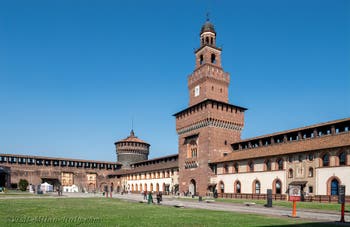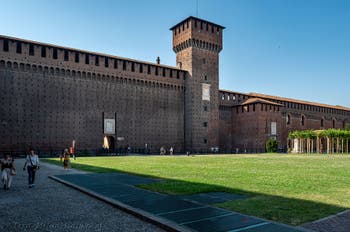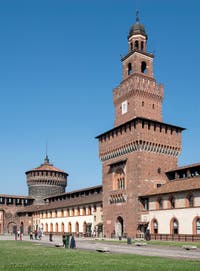Museums Ambrosiana | Castello Sforzesco | Poldi Pezzoli
Castello Sforzesco Art Story | Location | Opening Hours Tickets | Authorizations
Art Story The Castle | Leonardo da Vinci | Frescoes | Ducal Chapel | Standard Milan | Bernabo Visconti | F. Rusca
The Castello Sforzesco Museum, the Sforza Castle in Milan in Italy

The Weapons's Square of Castello Sforzesco When you arrive in front of the perimeter wall of Sforza Castle, and when you see the Weapons's Square as you pass under the high clock tower in the centre of the wall, you can only be impressed by the majesty, the power and the elegance of the castle.
This castle is a fortress that, however, contains artistic treasures inside its rooms where the Dukes of Milan resided.
The first castle was built between 1358 and 1368 by the Visconti on the current site of the Sforza Castle; it was called “Castrum Portae Jovis”, the castle of the Giova or Zioba Gate according to the local pronunciation.

Weapons's Square and Bona di Savoia Tower In 1447, after the death of Filippo Maria, the last of the Visconti, and in the absence of testamentary provisions, “L'Aurea Repubblica Ambrosiana”, the Ambrosian republic was established in Milan and lasted until 1450.
The Ambrosian Republic was a period of instability and turmoil during which the Visconti Castle suffered numerous spoliations.
After taking power by overthrowing the Ambrosian Republic, Francesco Sforza had four corner towers added.

Filarete Clock Tower In 1452, Sforza asked the architect Filarete to build the clock tower in the centre of the perimeter wall overlooking the Weapons's Square.
This 70-meter-high tower stands in the middle of a 200-meter-long wall.
You will pass under this tower to enter the Weapons's Square, guaranteed effect!
In 1456, the military architect Bartolomeo Gadio added two large towers to the castle's protective wall, which is now seven meters thick.
In short, Francesco Sforza knew the history of Milan and its successive dukes well and, therefore, preferred to take precautions to protect himself and his family.

Filarete Clock Tower The castle was now perfectly fortified while being superbly decorated and laid out so that Galeazzo Maria Sforza, Francesco's son, made it the primary residence of the Dukes of Milan.
Galeazzo Maria Sforza was assassinated outside his fortified castle during a mass in the church of Saint Stephen in Milan during the December 26, 1476 conspiracy.
The work to beautify the castle undertaken by Galeazzo Maria Sforza then ceased, to be resumed in 1480 by the regent Ludovic Maria Sforza, known as the More or il Moro.
Ludovico the More, il Moro, regent from 1480 to 1494, then became Duke of Milan from 1494 to 1500.
He accepted Leonardo da Vinci's proposal to fresco several rooms in the castle; while waiting for the restoration work to finish, you can admire the projections of the beautiful fresco that adorns the reception room, nicknamed the Axis Hall.
Art Story The Castle | Leonardo da Vinci | Frescoes | Ducal Chapel | Standard Milan | Bernabo Visconti | F. Rusca
Castello Sforzesco Art Story | Location | Opening Hours Tickets | Authorizations
Museums Ambrosiana | Castello Sforzesco | Poldi Pezzoli
Back to Top of Page

